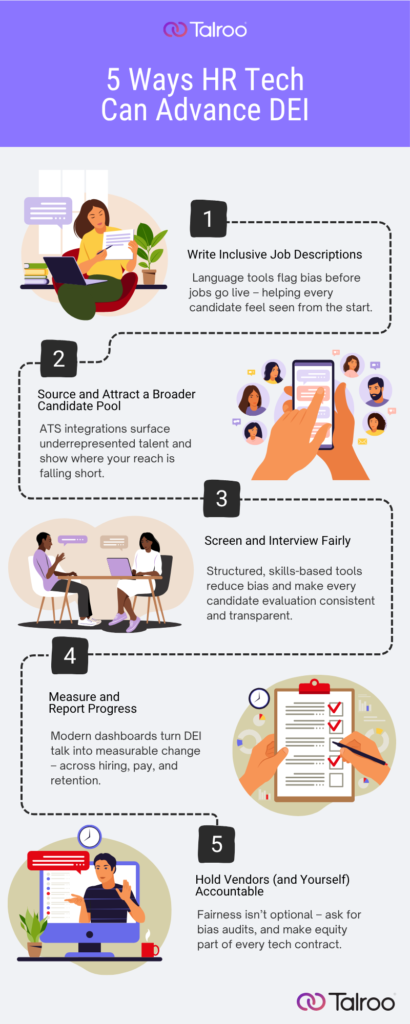
Advance Your DEI Strategy with HR Technology in 2025
Organizations have made progress in diversity, equity, and inclusion (DEI) over the last few years, but the work is far from finished. Today’s workforce (and regulators) are raising the bar. Job seekers expect transparency, employees want to see measurable action, and new laws are putting pressure on companies to demonstrate fairness and equity in their people practices.
HR technology is evolving just as quickly. Tools that once focused only on hiring efficiency are now being redesigned to detect bias, improve accessibility, and help leaders make data-driven decisions about DEI. The right HR tech strategy can ensure your organization’s commitment to diversity isn’t just talk. It shows up in every part of the employee experience.
What is a DEI Strategy (for HR & Recruiting)?
A DEI strategy in HR and recruiting is a deliberate, structured plan that integrates diversity, equity, and inclusion into every step of how an organization attracts, hires, assesses, and retains talent. It’s more than isolated initiatives; it’s embedding DEI goals and practices into the DNA of your people process.
Specifically, having a DEI strategy means:
- Diversity: Ensuring the candidate pool, employee population, leadership, etc., reflect a broad range of backgrounds — race, gender, age, ethnicity, disability, sexual orientation, neurodiversity, socio-economic background, education, thought, etc.
- Equity: Guaranteeing that every individual has fair access to opportunities (hiring, pay, promotion, development). This involves recognizing and removing systemic or structural barriers that disproportionately affect certain groups. Equity isn’t the same as treating everyone the same; it means adjusting for context so outcomes are fair.
- Inclusion: Creating an environment where all people feel welcomed, respected, heard, safe to contribute, and able to grow. It means not just having representation, but making sure that representation can thrive and be part of decision-making, belonging, and culture.
Key Components of a DEI Strategy in HR & Recruiting
Here are the core areas a robust DEI strategy should address:
| Component | What it means in practice |
| Goal-setting & leadership buy-in | Clear, measurable DEI goals (e.g. % representation, hiring source diversity, retention rates), with visible support and resources from senior leadership. |
| Inclusive hiring practices | Inclusive job descriptions, accessible application processes; structured interviews; skills-based assessments; transparent compensation; bias training for hiring managers. |
| Widening sourcing channels | Partnering with underrepresented talent networks; using diverse job boards; outreach to communities or schools; ensuring recruitment marketing is inclusive. |
| Bias mitigation & ethical tech | Auditing AI/ML tools, screening tools; monitoring for disparate impact; requiring vendor fairness/explainability; eliminating unnecessary filters or practices that disadvantage certain groups. |
| Data, feedback & metrics | Tracking DEI metrics not just in hiring, but in promotion, pay, retention, belonging. Employee surveys; feedback loops. Transparent dashboards. |
| Inclusion & employee experience | Onboarding, mentoring, sponsorship programs; ensuring psychological safety, inclusion in culture; accessibility; accommodation. |
| Continuous evaluation & improvement | Regularly reviewing what’s working / what isn’t; course-correcting; treating DEI as an ongoing journey—not a one-time project. |
Why DEI in 2025 Looks Different
A few major shifts are driving a new wave of DEI strategy:
- Rising compliance standards: Pay equity reporting, demographic disclosures, and AI bias audits are becoming more common requirements.
- Candidate expectations: Job seekers want to see your DEI commitments in action—from inclusive job descriptions to employee resource group (ERG) programs.
- AI and ethics: As AI is used more widely in recruiting and performance management, organizations must carefully monitor for bias and ensure explainability.
- Retention and belonging: Hiring diverse talent is only step one. Employees want to feel included, supported, and given equitable opportunities to grow.
Using HR Tech to Advance DEI
Here are the areas where HR technology can help you move from intention to impact:
1. Write Inclusive Job Descriptions
Your job postings are the first signal of your culture. Even small word choices can either welcome or discourage candidates. Tools like Textio and Gender Decoder highlight biased language and can help ensure your job descriptions appeal broadly.
Make inclusivity explicit by adding accommodation statements and highlighting your organization’s DEI values.
2. Source and Attract a Broader Candidate Pool
HR tech can help expand your reach to underrepresented groups. Applicant tracking systems now integrate with diversity job boards and community networks, while recruitment marketing platforms can track the effectiveness of those channels.
Don’t just post and hope. Use your ATS reporting features to monitor applicant flow and adjust sourcing strategies when certain groups are underrepresented. Talroo uses Greenhouse and there is an anti-bias feature called “Greenhouse Inclusion.” The system automatically provides a built-in “nudge” at each stage of the TA process, including the job description, to ensure that anti-bias best practices are followed.
3. Screen and Interview Fairly
Structured, skills-based assessments reduce reliance on resumes and pedigrees. Tools such as Wonderlic and HireVue are still widely used, but in 2025 they’re being held to a higher standard: candidates want transparency, and organizations need to ask for vendor bias audits.
Accessibility also matters. Ensure your video interview platforms support captioning, your application process is screen-reader friendly, and candidates can request accommodations easily.
4. Measure and Report Progress
Real progress requires real data. Modern HR dashboards track DEI across the full employee lifecycle: hiring funnel, promotion rates, pay equity, turnover, and even inclusion survey scores. Tools like Greenhouse Inclusion help embed bias checks and nudges into hiring workflows, while advanced people analytics platforms integrate DEI metrics with broader business outcomes.
Be transparent with employees and candidates about your goals and your progress—even if you’re not where you want to be yet.
5. Hold Vendors (and Yourself) Accountable
DEI isn’t only about internal processes. When you use third-party tools, you’re trusting their algorithms, sourcing strategies, and assessments. Ask for their fairness data, bias audits, and explainability reports. Build expectations for equity and compliance into your vendor contracts.
Internally, conduct annual reviews of your HR tech stack: Is it helping you meet your DEI goals, or creating new barriers?

What’s New in 2025
Alongside the familiar tools, several newer practices are shaping DEI and HR tech this year:
- Bias monitoring platforms that continuously analyze hiring funnels for disparities.
- Accessibility technology built into candidate platforms for neurodivergent and disabled applicants.
- Employee-voice tools that capture real-time feedback on inclusion and belonging.
- Privacy and consent features that allow candidates to control how their personal data is used.
These aren’t “nice to haves.” They’re quickly becoming the standard for organizations that want to compete for talent and comply with evolving regulations.
Action Steps for HR Leaders
To make sure your DEI strategy keeps pace in 2025:
- Audit your job descriptions for inclusive language.
- Review your sourcing channels for reach and representation.
- Ensure assessments and interviews are skills-based, structured, and accessible.
- Track DEI metrics at every stage of the employee lifecycle.
- Request accountability from vendors and conduct bias audits regularly.
DEI is no longer an initiative. It’s an expectation. The combination of evolving technology, regulatory change, and workforce demand means organizations must use every tool available to advance inclusion. By thoughtfully integrating HR technology into your DEI strategy, you’ll not only meet compliance and attract diverse candidates, you’ll build a workplace where people want to stay and grow.
If you enjoyed this article, you might also like:
How to Make your Job Postings More Inclusive | Talroo
Where to Start With Diversity and Inclusion Recruiting Efforts | Talroo
Diversity and Inclusion Planning Basics for TA Leaders | Talroo




